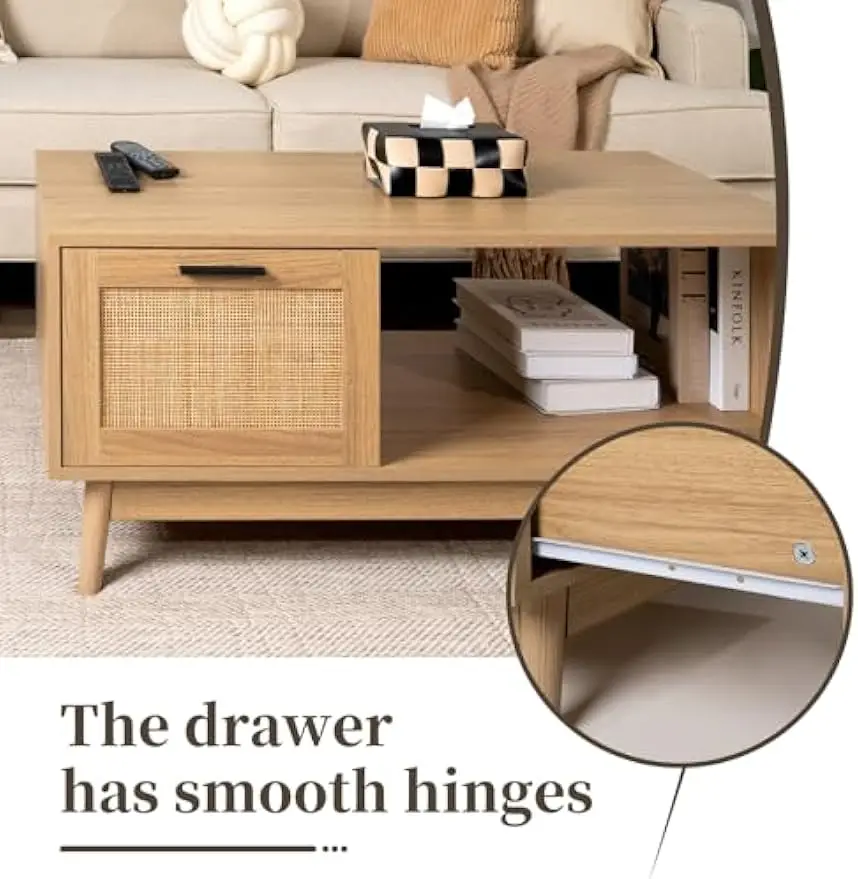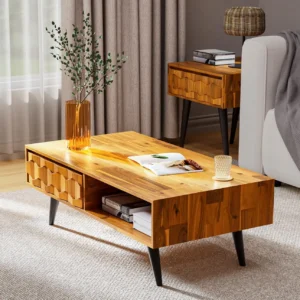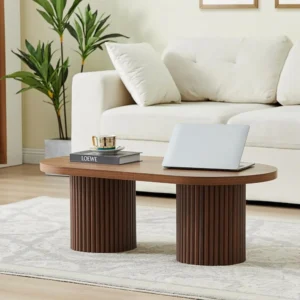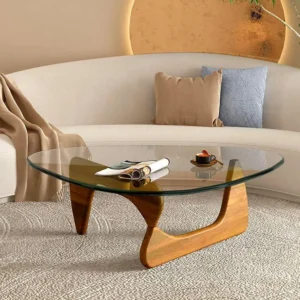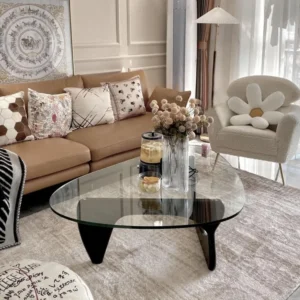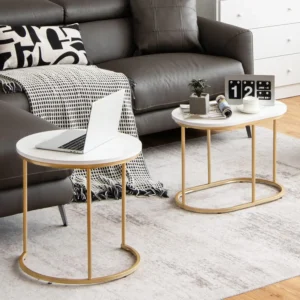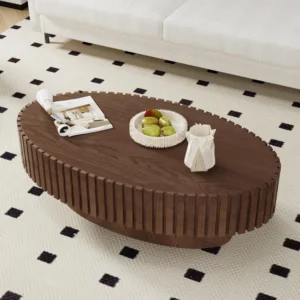Introduction: The Enduring Charm of Danish Coffee Tables
The allure of Danish coffee tables lies in their perfect harmony of simplicity and sophistication. These iconic pieces represent more than just furniture; they embody a design philosophy that has remained relevant and coveted for decades. Danish coffee tables stand apart through their seamless blend of organic forms with clean, purposeful lines—creating pieces that feel both timeless and thoroughly modern.
What makes these tables so enduring is their unwavering commitment to balancing aesthetic beauty with practical functionality. Unlike purely decorative pieces, Danish-inspired coffee table designs prioritize human interaction, comfort, and everyday usability while never compromising on visual appeal.
In this comprehensive guide, we’ll explore the core principles behind Danish coffee tables, help you identify authentic design features, provide selection guidance for your space, and share styling and maintenance tips to ensure your piece remains beautiful for generations. Whether you’re a dedicated design enthusiast or simply seeking a quality centerpiece for your living space, understanding Danish modern coffee table elements will transform how you approach interior design decisions.
The Essence of Danish Design Philosophy
To truly appreciate Danish coffee tables, one must understand the philosophy that shapes them. The Danish design approach emerged from a desire to create beautiful yet accessible furniture that enhances everyday life. This mindset continues to influence contemporary pieces available today.
Core principles that define Danish modern design include:
- Minimalism with purpose: Clean lines and uncluttered forms that eliminate excess without sacrificing character
- Functionality first: Every element serves a purpose—there’s no ornamentation for its own sake
- Exceptional craftsmanship: Meticulous attention to detail and joinery that celebrates the construction process
- Natural material honesty: Materials—especially wood—are selected and finished to highlight their inherent beauty
- Human-centered proportions: Dimensions and forms that relate to the human body and movement
- “Hygge” sensibility: The famous Danish concept of coziness and comfort integrated into the design approach
These principles explain why mid-century modern Danish coffee tables remain so sought-after. The design movement emerged in the mid-20th century but continues to resonate with contemporary interiors because it addresses fundamental human needs for both beauty and function.
The philosophy prioritizes sustainability through longevity—creating pieces meant to last generations rather than following temporary trends. This thoughtful approach to design results in coffee tables that remain relevant across changing interior styles and key characteristics of Danish coffee tables that transcend time.
Signature Elements of Authentic Danish Coffee Tables
Recognizing authentic Danish coffee table design requires understanding specific visual elements that define the style. These distinctive features create the signature look that design enthusiasts immediately recognize.
The most notable characteristics include:
Sculptural Legs and Supports: Look for slender, tapered legs that angle outward slightly—often referred to as “splayed” legs. This subtle detail creates visual dynamism and stability. Some designs feature more sculptural bases with organic curves that showcase the designer’s artistry.
Refined Proportions: Danish tables maintain precise relationships between height, width, and depth. The tabletop typically appears to “float” above the base with a lightness that belies its sturdy construction.
Visible Joinery as Design: Rather than hiding construction methods, Danish design celebrates them. Look for visible tenon joints, finger joints, or other woodworking details that serve as subtle decoration while showcasing craftsmanship.
Material Emphasis: Surfaces highlight the natural beauty of wood grain rather than concealing it. This appreciation for natural patterns creates pieces that feel connected to nature despite their refined forms.
Subtle Organic Curves: While maintaining clean lines overall, authentic Danish tables incorporate gentle curves that soften geometric forms—particularly at edges and transitions between elements.
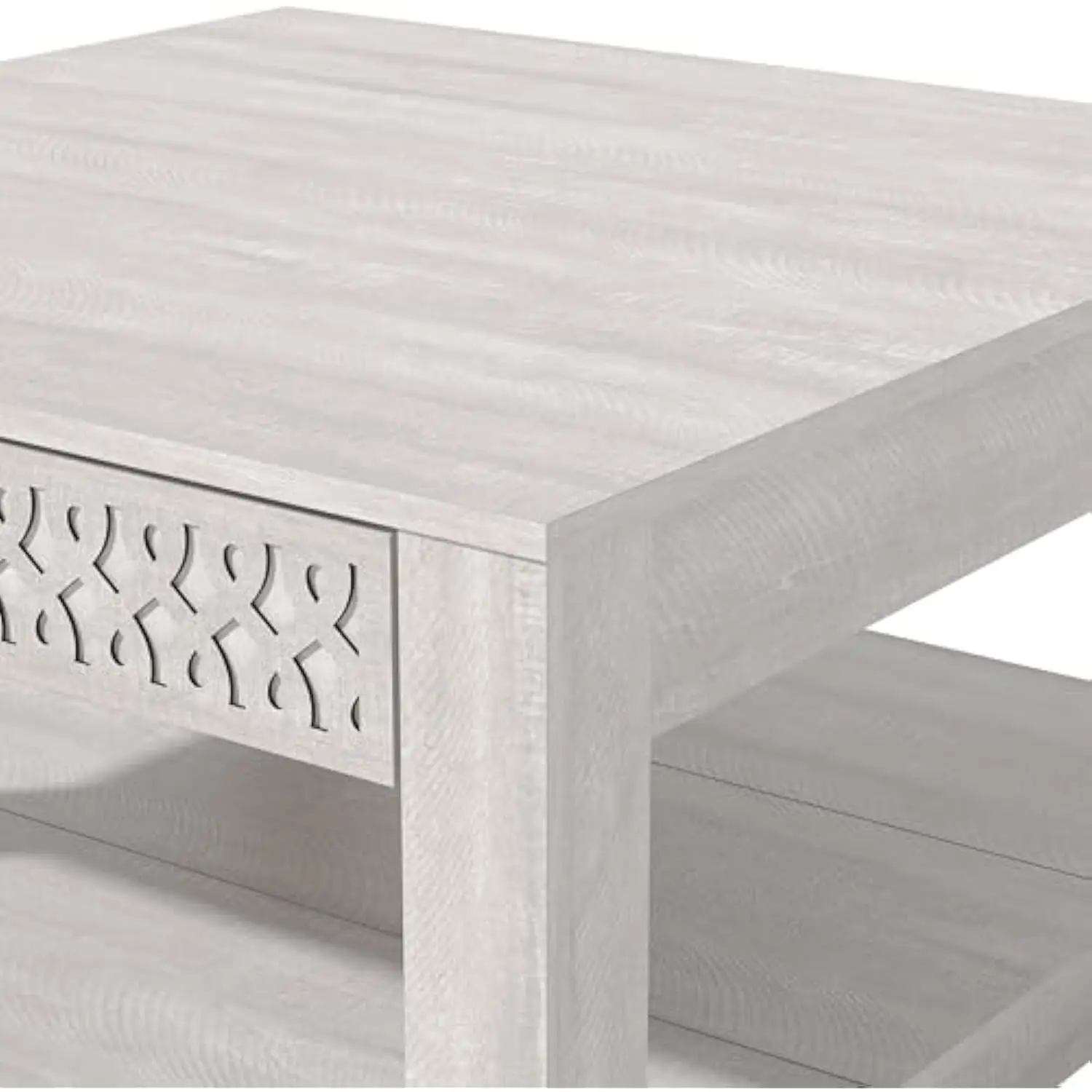
These design elements work together to create coffee tables that feel light yet substantial, refined yet warm. The best solid wood coffee tables in the Danish tradition maintain these characteristics while expressing the unique vision of their creators. Many collectors particularly prize walnut coffee table designs for their rich color variation and distinctive grain patterns.
Materials and Craftsmanship: The Danish Difference
The exceptional quality of Danish coffee tables stems largely from their materials and craftsmanship. The selection of woods and finishing techniques significantly impacts both appearance and longevity.
Distinguished Woods in Danish Design
Teak: Prized for its natural oils that provide water resistance and a golden-brown hue that deepens with age. Teak develops a distinctive silver-gray patina over decades if left untreated, which many collectors value. Teak coffee tables remain among the most sought-after Danish pieces.
Oak: Offers exceptional durability with a prominent grain pattern. Danish designers often used oak for its strength and versatility, applying various treatments to achieve different effects—from light, natural finishes to darker tones.
Rosewood: Features dramatic grain patterns and rich, dark coloring. Most authentic rosewood pieces today are vintage due to current harvesting restrictions. These pieces often command premium prices for their distinctive beauty and historical significance.
Other Notable Woods: Walnut (for its rich color variation), beech (for its smooth texture), and birch (for its light, uniform appearance) all appear in classic Danish designs.
Traditional Finishing Techniques
Danish craftsmen traditionally used oil finishes that penetrate the wood rather than forming a surface film. This approach enhances rather than masks the natural grain while providing protection. The resulting low-luster finish develops character over time, with each mark and patina telling the story of the piece.
Danish coffee table construction craft emphasizes joinery that will last generations—mortise and tenon joints, finger joints, and precise dowel construction. These methods create furniture that can be repaired rather than replaced, embodying sustainability through longevity.
Quality pieces feature consistent attention to detail even in unseen areas—smooth drawer interiors, finished undersides, and balanced proportions throughout. These hallmarks distinguish exceptional Danish coffee tables from mere imitations.
Selecting the Perfect Danish Coffee Table for Your Space
Finding the right Danish coffee table involves careful consideration of your space, needs, and existing furniture. The perfect table should feel proportional while serving your practical requirements.
Size and Proportion Guidelines
Height Considerations: The ideal coffee table sits 1-2 inches lower than your sofa seat cushions—typically 17-19 inches tall. This height ensures comfortable use without obstructing conversation or views across the room.
Length Proportion: For balanced composition, choose a table approximately two-thirds the length of your sofa. This creates visual harmony while providing adequate surface area.
Clearance Space: Maintain 14-18 inches between the coffee table and seating for comfortable leg room. This space allows for easy movement while keeping the table within comfortable reach.
Shape Selection for Your Layout
Rectangular Tables: Best for larger seating arrangements or traditional layouts with a standard sofa as the anchor piece. These provide maximum surface area and often include storage options.
Round or Oval Tables: Ideal for smaller spaces or conversation areas with seating on all sides. Round coffee tables soften rooms with many angular elements and improve traffic flow by eliminating sharp corners.
Organic Shapes: Free-form or asymmetrical tables make striking centerpieces and work particularly well in creative or eclectic spaces.
When measuring your space, consider not just the available area but how people move through the room. Danish design excels at creating furniture that complements human movement patterns. For homes with limited square footage, coffee table sizes for small living rooms require special consideration to maintain both function and visual balance.
The best Danish coffee tables achieve a delicate balance between serving as statement pieces and harmonizing with your existing décor—commanding attention without overwhelming the space.
Danish Coffee Tables in Different Interior Styles
The versatility of Danish coffee tables allows them to enhance various interior design approaches. Their clean lines and natural materials create a chameleon-like ability to adapt to different surroundings.
Scandinavian Minimalist
In this light, airy aesthetic, opt for Danish tables with blonde woods like ash or birch. Their restrained forms complement the Scandinavian preference for uncluttered spaces and natural light. Pair with simple textiles in neutral tones and minimal accessories to maintain the serene atmosphere essential to this style.
Mid-Century Modern
Danish coffee tables find their most natural home in mid-century interiors. Choose pieces with warm-toned woods like teak or walnut to complement the characteristic color palette. The organic modernism of Scandinavian Danish coffee table design pairs beautifully with iconic seating pieces from the same era.
Contemporary
In contemporary settings, Danish coffee tables provide a touch of warmth and craftsmanship that balances sleeker elements. Their clean lines harmonize with modern furniture while their natural materials soften minimalist spaces. Consider nesting coffee tables for flexible functionality in contemporary living rooms.
Eclectic/Bohemian
Danish pieces serve as grounding elements in eclectic spaces, providing a sophisticated foundation for more exuberant textiles, art, and accessories. Their refined simplicity creates a visual resting place amid diverse colors and patterns.
Traditional
In traditional settings, Danish coffee tables introduce a casual elegance that prevents spaces from feeling stuffy or overly formal. Their craftsmanship complements traditional values while their clean lines offer a refreshing counterpoint to more ornate elements.
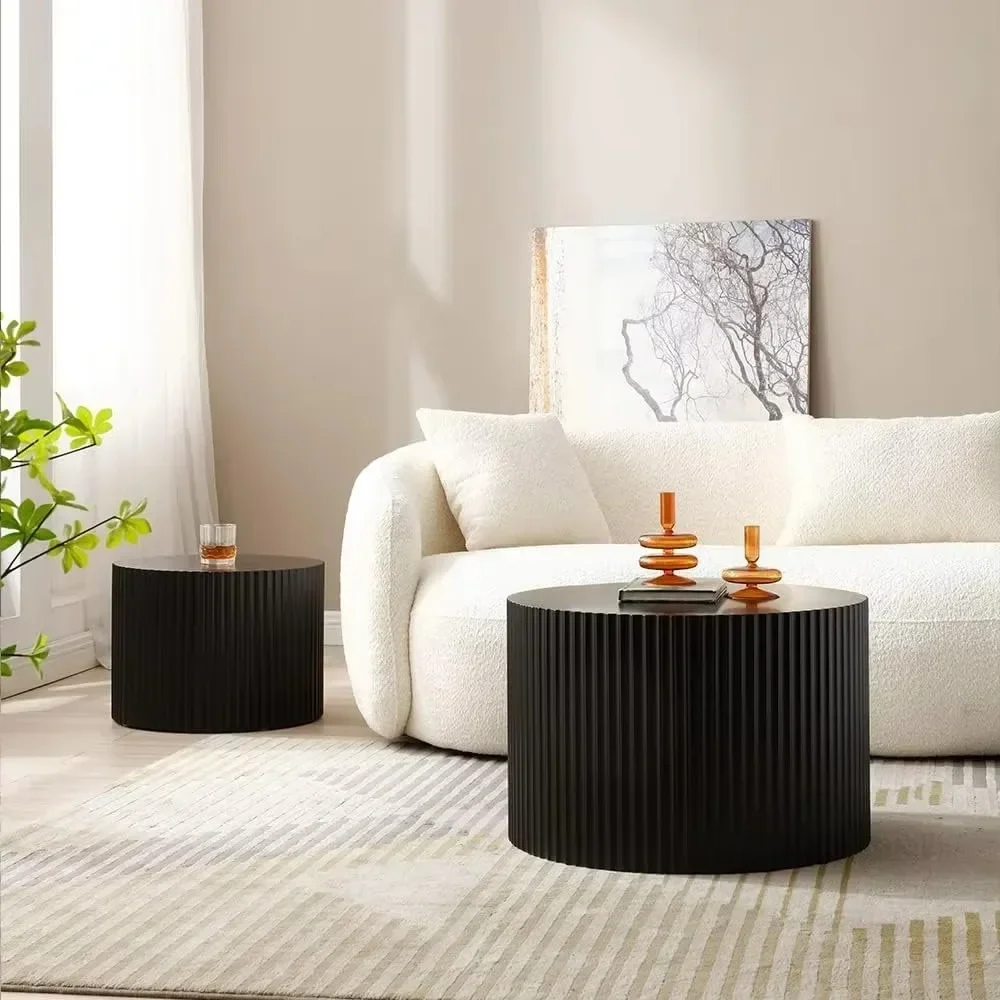
Regardless of your interior style, Danish coffee tables integrate most successfully when they share at least one element—color tone, material quality, or line direction—with existing pieces in your space.
Styling Your Danish Coffee Table: The Art of Balance
The inherent beauty of Danish coffee tables deserves thoughtful styling that enhances rather than overwhelms their design. The goal is to create purposeful arrangements that balance form and function.
Core Styling Principles
The Rule of Three: Group objects in odd numbers (typically three) for visual interest. Vary heights and shapes within these groupings to create dynamic compositions.
Height Variation: Include at least one taller element (like a vase or sculptural object) alongside medium and low-profile items to create visual movement across the table surface.
Textural Contrast: Combine different materials—ceramics, books, wood, metal, or glass—to create tactile interest that complements the table’s own materials.
Negative Space: Resist the urge to fill every inch. Danish coffee tables in minimalist design look best when given breathing room. Allow some empty space to highlight both your chosen objects and the table’s own design.
Styling Approaches for Different Effects
Minimalist Arrangement: A single striking object (like a sculptural bowl) or two complementary items with substantial negative space. This approach highlights the table itself.
Curated Collection: A thoughtfully arranged group of objects that share a theme, color palette, or material quality. Consider a stack of art books with a small sculpture and a unique container.
Functional Focus: Emphasize usability with a serving tray containing practical items like coasters, a candle, and perhaps a small vessel for flowers. This approach prioritizes everyday utility.
Remember that styling should adapt to how you actually use the space. Allow room for coffee cups, reading materials, or technology if your coffee table serves as a true center of activity rather than just a display surface.
New vs. Vintage: Making the Right Investment
When adding a Danish coffee table to your home, choosing between contemporary and vintage pieces presents different advantages depending on your priorities.
Contemporary Danish-Inspired Tables
Advantages:
– Pristine condition without previous wear
– Often more affordable than authentic vintage pieces
– Potentially better suited to contemporary living needs
– More consistent availability when you need a specific size or shape
When selecting modern interpretations, look for quality indicators like solid wood construction, proper joinery methods, and finishing techniques that highlight natural grain. Quality reproductions honor Danish design principles rather than merely mimicking surface aesthetics.
Authentic Vintage Pieces
Advantages:
– Character and patina developed over decades
– Superior craftsmanship often using old-growth woods
– Potential investment value as demand for mid-century pieces continues
– Environmental benefits of reusing existing furniture
When considering vintage coffee tables, examine structural stability, checking for loose joints or previous repairs. Some wear is expected and often adds character, but structural issues may require professional restoration.
Understanding the difference between terms like mid-century versus mid-century modern furniture helps navigate the market more effectively. True Danish modern pieces typically feature higher quality materials and construction than generic mid-century furniture.
Price expectations vary widely, with authentic vintage designer pieces commanding premium prices ($1,000-5,000+) while quality contemporary interpretations range from $500-2,000 depending on size, materials, and craftsmanship.
Mid-Century Modern Solid Wood Coffee Tables, Mid-Century Modern Teak Coffee Tables
$879.95 Select options This product has multiple variants. The options may be chosen on the product pageMid-Century Modern Danish Coffee Tables, Mid-Century Modern Oval Coffee Tables, Mid-Century Modern Solid Wood Coffee Tables
$390.05 Select options This product has multiple variants. The options may be chosen on the product pageMid-Century Modern Glass Top Coffee Tables, Mid-Century Modern Glass Top Side & End Tables
$460.58 Select options This product has multiple variants. The options may be chosen on the product pageMid-Century Modern Glass Top Coffee Tables, Mid-Century Modern Vintage Coffee Tables, Mid-Century Modern Vintage Side & End Tables
$725.36 Select options This product has multiple variants. The options may be chosen on the product pageMid-Century Modern Nesting Coffee Tables, Mid-Century Modern Nesting Table Sets
$361.45 Select options This product has multiple variants. The options may be chosen on the product pageMid-Century Modern Oval Coffee Tables, Mid-Century Modern Solid Wood Coffee Tables
$679.56 Select options This product has multiple variants. The options may be chosen on the product page
Care and Maintenance: Preserving Danish Beauty
Proper care ensures your Danish coffee table remains beautiful for generations. Different finishes require specific approaches to maintenance.
Daily and Weekly Care
- Dust regularly with a soft, lint-free cloth, moving with the wood grain
- Immediately blot (never rub) any spills to prevent moisture damage
- Use coasters for drinks and placemats for hot items
- Rotate decorative objects periodically to prevent uneven sun exposure
Finish-Specific Maintenance
Oil-Finished Wood:
– Apply food-grade mineral oil or specialized wood oil every 3-6 months
– Test in an inconspicuous spot first
– Apply sparingly, following the grain, then buff excess after 15 minutes
Lacquered Surfaces:
– Clean with a slightly damp cloth, never saturated
– Use specialized wood cleaners formulated for lacquered finishes
– Avoid silicone-based products that can build up over time
Common Issues:
– For water rings, try a mixture of equal parts vinegar and olive oil
– Minor scratches in oil-finished wood often respond to a fresh oil application
– Protect from direct sunlight which can cause uneven fading
Seasonal shifts in humidity require attention, as wood naturally expands and contracts. Maintain consistent indoor humidity (40-60%) when possible, and position tables away from heat sources and air conditioning vents.

The combination of wood with other materials, as seen in glass-top coffee tables, requires specific care approaches for each component. Glass elements should be cleaned with appropriate glass cleaners applied to the cloth rather than directly to surfaces to prevent seepage into wood joins.
Common Mistakes to Avoid with Danish Coffee Tables
Even with the best intentions, certain missteps can diminish the impact of Danish coffee tables in your space. Awareness of these common errors helps create more successful interior compositions.
Design Selection Missteps
Disproportionate Sizing: Choosing tables too large for the room creates awkward traffic patterns, while undersized pieces appear lost and impractical. Measure your space and consider how people move through it before committing.
Overlooking Functional Requirements: Selecting a beautiful table that doesn’t serve your daily needs leads to frustration. Consider how you actually use your living space—for entertaining, working, casual dining—and choose accordingly.
Style Misalignment: Danish pieces work in many contexts but require some design cohesion. Ensure at least one connecting element (material, color tone, or line quality) bridges your table to existing furniture.
Authenticity Confusion: Purchasing poorly-made imitations that lack proper construction methods. Learning about identifying Danish-inspired coffee tables helps distinguish quality pieces from superficial copies.
Styling and Arrangement Errors
Overcrowding: Filling every inch of surface area diminishes both functionality and visual impact. Danish design celebrates “breathing room” around objects.
Height Imbalance: Using only low-profile items creates a flat, uninteresting arrangement. Include elements of varying heights to create visual movement.
Ignoring Negative Space: Strategic emptiness enhances composition. Not every corner needs filling—restraint showcases both your selected objects and the table itself.
Inconsistent Material Language: Mixing too many disparate materials and styles in tabletop accessories creates visual chaos rather than harmonious composition.
Avoiding these common mistakes ensures your Danish coffee table becomes a successful focal point that enhances your entire living space while remaining practical for everyday life.
Will a Danish Coffee Table Work in a Small Space?
Danish coffee tables excel in smaller living environments precisely because their design philosophy emphasizes efficiency without sacrificing beauty. Their human-scaled proportions and visual lightness make them ideal for compact spaces.
Space-Efficient Options
Nesting Table Sets: Perhaps the most versatile solution, these provide expandable surface area when needed while storing compactly. Pull out secondary tables for guests, then tuck them away to reclaim floor space.
Round or Oval Designs: These shapes eliminate sharp corners that interrupt movement in tight spaces. Their flowing forms create better traffic patterns and reduce visual weight.
Raised Designs with Visible Floor: Tables with slender legs and open undercarriages create visual transparency that makes rooms feel larger. The visible floor beneath creates continuity that visually expands the space.
For maximum space efficiency in urban apartments, consider compact coffee table buying guide recommendations such as tables between 30-36 inches in length with heights around 16-18 inches. Position these pieces at least 12 inches (but ideally 14-16 inches) from seating to maintain comfortable clearance while conserving space.

The clean lines and thoughtful proportions of Danish design make these tables particularly effective in small spaces. Their inherent functionality—often incorporating storage or expandable elements—provides practical solutions without the bulkiness of many contemporary alternatives.
How to Mix Danish Coffee Tables with Other Furniture Styles
The versatility of Danish coffee tables allows them to integrate successfully with diverse furniture styles. This adaptability comes from their balanced proportions and honest materials that create natural dialogue with other quality pieces.
Principles for Successful Style Mixing
Find Connecting Elements: Identify at least one shared quality between your Danish table and other pieces—perhaps a similar wood tone, comparable line quality, or complementary scale. This creates visual coherence amid stylistic diversity.
Create Intentional Contrast: Pair the organic warmth of Danish wood with contrasting elements like industrial metal or contemporary upholstery. This deliberate juxtaposition highlights the special qualities of each piece.
Maintain Proportion Balance: Ensure your coffee table doesn’t appear overwhelmed by surrounding furniture. A delicate Danish piece needs breathing room among heavier elements, while substantial Danish tables can anchor lighter surrounding pieces.
Complementary Style Pairings
Danish coffee tables work particularly well alongside:
– Mid-century seating with similar organic-modern sensibilities
– Contemporary sofas whose clean lines echo Danish simplicity
– Industrial elements where Danish warmth softens metal and concrete
– Traditional pieces when the Danish table provides a cleaner counterpoint
To maintain cohesion when mixing styles, use textiles, artwork, and accessories as transitional elements that reference colors and textures from different pieces. A rug that incorporates tones from both your Danish table and other furniture creates visual connection without forced matching.
The evolution of modern Danish coffee table design continues to influence contemporary furniture, creating natural bridges between different eras and aesthetics. This ongoing design dialogue makes Danish pieces particularly versatile foundations for eclectic yet harmonious interiors.
Danish coffee tables ultimately transcend simple categorization. Their enduring appeal stems from fundamental design principles that speak to human needs for both beauty and function—making them timeless additions to thoughtfully curated homes.

